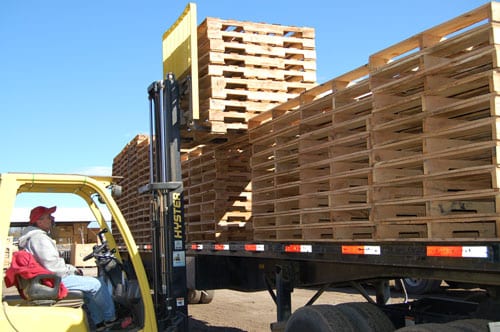Knowing how to calculate the size and weight of your pallet shipments can help you estimate shipping costs accurately. Bizfluent’s article How to Calculate Pallet Size explains how to determine the volume and dimensional weight of your pallet shipments.
Calculating Volume
- Measure the length and width of the pallet base in inches. If there is no overhang, then the length and width should be the same as the dimensions of the pallet. If your product does hang over the edge of the pallet, include it in your measurements by measuring to the outermost point of the product.
- Measure the height of the pallet shipment in inches. Measure from the ground up to the highest point to include both the pallet and the shipment.
- Find the overall volume by multiplying the length by the width by the height (L x W x H).
Bizfluent Example: If you have a 48×40 standard pallet with no overhang, and the height of the pallet itself measures 8 inches, and the height of the shipment on top of the pallet measures 42 inches, then:
Length of pallet base: 48 inches
Width of pallet base: 40 inches
Height of entire pallet shipment: 8 inches + 42 inches = 50 inches
Overall volume of pallet shipment: 48 inches x 40 inches x 50 inches = 96,000
cubic inches
Calculating Dimensional Weight
As UPS explains, “Dimensional weight reflects pallet density, which is the amount of space a pallet occupies in relation to its actual weight.” Or, as Bizfluent puts it, “a unit of measurement used by shipping companies to account for lightweight cargo that takes up a lot of space.”
Companies like UPS and FedEx use a dimensional weight divisor of 139. To find the dimensional weight of your pallet shipment, divide the cubic size (LxWxH) by 139.
- UPS notes, when measuring the length, width and height of your shipment, round each measurement to the next whole number (1.49 would be considered as 1, while 1.5 would be considered as 2), and increase any fraction in the quotient to the next whole pound.
Bizfluent Example: If the cubic size of your pallet shipment is 96,000 cubic inches, then:
Dimensional weight: 96,000 cubic inches / 139 = 690 Ibs.
Tips for Lowering Shipping Costs
Bizfluent gives a few quick tips on how to prepare your pallet to lower shipping costs:
- “Attempt to cover the entire surface of the pallet and keep the height of the packages as low as possible.”
- “If the pallet consists of only a few packages that don’t cover the entire area, consider using a smaller pallet for the shipment.”
- “If you have an odd box or two on top of an otherwise level stack, consider shipping those boxes separately to reduce the overall height of the pallet.”
General Pallets wants to help you optimize your pallet shipments as much as possible. We offer custom pallet and crating designs, so we can meet your unique needs, no matter what they are. Contact us today!


